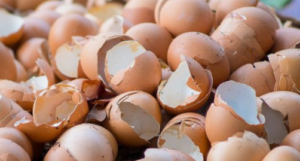When it comes to using egg shells in your garden and flowerbeds, the sky is the limit.
They are one of the most useful and powerful organic substances around. And you just might be amazed at how many ways they can be helpful in maintaining a healthy landscape!
Egg shells are filled with a slew of nutrients. In addition to calcium, they also contain trace elements of phosphorous, magnesium and other minerals.
All of which are very important in building and maintaining healthy soil, and in turn, growing healthy plants.
But the benefits go beyond simply improving soil health. Egg shells are also helpful in the fight against pests such as slugs. In fact, when you look at all of their benefits, it’s hard to ever imagine simply tossing an eggshell into the garbage again!
Here is a look at a few great ways to use egg shells in your landscape, and turn this breakfast by-product into a powerhouse for your plants.
How To Use Egg Shells In The Landscape In The Vegetable Garden.
In the vegetable garden, egg shells are perfect for building soil, helping fend off disease, and controlling pests.
Calcium is a major component needed for growing healthy, vigorous vegetable plants. And unfortunately, many gardens face a lack of this all important mineral in their soil.
Using egg shells in the planting holes of young tomatoes can help reduce the chance for blossom end rot.
In fact, the lack of available calcium in the soil is the cause of one of the biggest issues tomato growers face – blossom rot,
Without enough calcium, the ends of young tomatoes turn black and rot away. The same issue can happen to pepper plants and other vegetables as well.
Calcium is also critical in the development of a vegetable plant’s cell structure. Without enough, young seedlings are unable to develop thick walls and strong roots.
The result is a weaker plant with fewer blooms, and of course, a smaller harvest.
More calcium in the soil means healthier plants and more tomatoes!
But calcium rich shells can help with all of the above and more. By simply crushing up and adding 4 to 5 egg shells into each planting hole, you can help replenish the calcium in the soil.
As the shells break down, they help to release the calcium the plants need.
This is a great practice for all of your vegetable transplants, as the additional nutrients provide power to the soil and the plants roots.
Protecting Against Slug Damage.
Egg shells can also help protect tender young plants in the garden from slugs.
The jagged edges of shells can keep slugs away from both vegetable and flower plants.
Even better, as the shells break down, they only serve to add more nutrients to the soil. For this reason, many gardeners use crushed shells around all of their plants, including potted plants as well.
When crushed and placed around the base of the plant, the sharp, jagged edges of the shells form a protective barrier. A barrier that the smooth, slimy, outer skin of slugs can’t cross without being cut.




